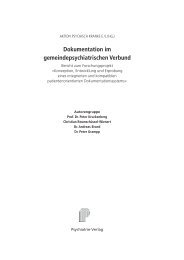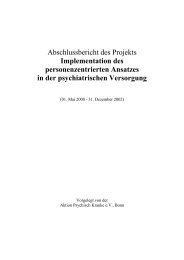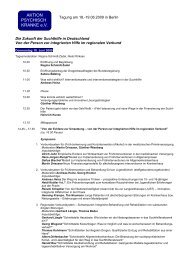"25 Jahre Psychiatrie-Enquete" Teil II - Aktion Psychisch Kranke e.V.
"25 Jahre Psychiatrie-Enquete" Teil II - Aktion Psychisch Kranke e.V.
"25 Jahre Psychiatrie-Enquete" Teil II - Aktion Psychisch Kranke e.V.
Erfolgreiche ePaper selbst erstellen
Machen Sie aus Ihren PDF Publikationen ein blätterbares Flipbook mit unserer einzigartigen Google optimierten e-Paper Software.
Schlussfolgerung<br />
Die Schließung großer psychiatrischer <strong>Kranke</strong>nhäuser ist jetzt größtenteils<br />
abgeschlossen, und ein Netzwerk von gemeindenahen psychiatrischen<br />
Teams ist entstanden. England beschreitet die nächste<br />
Entwicklungsphase der Gemeindepsychiatrie. Ernsthafte Bemühungen<br />
werden unternommen, die Lücken in der psychiatrischen Versorgung<br />
zu erkennen und zu verringern. Da England ein nationales<br />
Gesundheitssystem hat, können zentrale Entscheidungen getroffen<br />
und neue politische Richtlinien relativ schnell herausgebracht werden,<br />
jedoch kann sich die Durchführung dieser als schwierig erweisen.<br />
Die entscheidende Erfolgsdeterminante der gegenwärtigen<br />
Initiativen werden wahrscheinlich die Ergebnisse aller Bemühungen<br />
sein, die Rekrutierung, Anbindung und Moral der psychiatrischen<br />
Mitarbeiter zu verbessern.<br />
Literatur<br />
Sonia Johnson, Martin Zinkler und Stefan Priebe Psychiatrische Gesundheitsversorgung in Großbritannien<br />
1. DEPARTMENT OF HEALTH. National Service Framework for Mental<br />
Health – Modern standards and service models. London: The Stationery<br />
Office 1999.<br />
2. DEPARTMENT OF HEALTH. The NHS Plan. London: The Stationery<br />
Office 2000.<br />
3. JOHNSON S, LELLIOTT P. Mental health services in London: evidence<br />
from research and routine data. In JOHNSON S, RAMSAY R, THORNI-<br />
CROFT G. et al., (eds) London’s Mental Health. London: Kings Fund<br />
1997.<br />
4. DEPARTMENT OF HEALTH. Memorandum for the Select Committee on<br />
Health: Public expenditure questionnaire 2000. Published on the<br />
Internet at: http://www.parliament.the-stationery-office.co.UK/pa/<br />
cm199900/cmselect/cmhealth/882/88210.htm 2000<br />
5. KILLASPY H, DALTON J, MCNICHOLAS S, JOHNSON S. Drayton Park, an<br />
alternative to hospital admission for women in acute mental health crisis.<br />
Psychiatric Bulletin 2000: 24: 101–104.<br />
6. TRIEMAN N, LEFF J, GLOVER G. Outcome of long stay psychiatric<br />
patients resettled in the community: prospective cohort study. British<br />
Medical Journal 1999: 319:13–16.<br />
7. GOVERNMENT STATISTICAL SERVICE. Hospital Activity Statistics.<br />
Published on the Department of Health website at: http://<br />
www.doh.gov.UK/hospitalactivity/statistics 2000.<br />
8. GOVERNMENT STATISTICAL SERVICE. Hospital Episode Statistics<br />
(preliminary reports) London: Published on the Department of Health<br />
website at: http://www.doh.gov.UK/hes/standard_data/available_tables.<br />
2001<br />
9. JOHNSON S, THORNICROFT G. The sectorisation of psychiatry in England<br />
and Wales. Social Psychiatry and Psychiatric Epidemiology 1993: 28: 45–<br />
47.<br />
10. PECK E. Introduction to special section on community mental health<br />
teams. Journal of Mental Health 1999:8: 215–216.<br />
11. JOHNSON S, BROOKS L, RAMSAY R, THORNICROFT G. the structure and<br />
functioning of London’s mental health services. In JOHNSON S, RAMSAY<br />
R, THORNICROFT G. et al. (eds) London’s Mental Health. London:<br />
Kings Fund, 1997.<br />
12. BURNS T, PRIEBE S. Mental health care failure in Britain: myth and<br />
reality. British Journal of Psychiatry 1999: 174: 191–2.<br />
13. WARDEN J. England abandons care in the community for the mentally ill.<br />
BMJ 1998: 317:1611.<br />
14. TAYLOR P, GUNN J. Homicide by people with mental illness: myth and<br />
reality. British Journal of Psychiatry 1999: 174: 9–14.<br />
15. CRISP A, GELDER M, RIX S, MELTZER H, RoWLANDS O. Stigmatisation<br />
of people with mental illnesses. British Journal of Psychiatry 2000: 177:<br />
4–7.<br />
16. BYRNE P. Stigma of mental illness: changing minds, changing behaviour.<br />
British Journal of Psychiatry 1999: 174: 1–2.<br />
17. SAYCE L. Social inclusion and mental health. Psychiatric Bulletin 2001:<br />
<strong>25</strong>: 121–123.<br />
18. SAYCE L, CHRISTIE Y, COBB A, SLADE M. Users’ Perspectives on<br />
Emergency Needs in Pheland Dr M., Strathdee Dr G and Thornicroft<br />
Dr G (Eds) Emergency Mental Health Services in the Community.<br />
Cambridge: Cambridge University Press 1994.<br />
19. SMYTH M, HOULT J. The Home Treatment enigma. BMJ 2000: 320:<br />
305–308.<br />
20. PELOSI A, JACKSON G. Home treatment: enigmas and fantasies. BMJ<br />
2000: 320: 308–309.<br />
21. BURNS T. Home treatment: Vigorous well designed trials are needed.<br />
British Medical Journal 2000: 321: 177.<br />
22. SAINSBURY CENTRE FOR MENTAL HEALTH. Keys to engagement.<br />
London: The Sainsbury Centre 1998.<br />
23. TYRER P. Are small caseloads beautiful in severe mental illness? The<br />
British Journal of Psychiatry 2000: 177: 386–387.<br />
24. STEIN L.I., SANTOS AB. Assertive Community Treatment of Persons<br />
with Severe Mental Illness. London and New York: W.W. Norton 1998.<br />
<strong>25</strong>. WEAVER T, RENTON A, STIMSON G, TYRER P. Severe mental illness and<br />
substance misuse. BMJ 1999: 318: 137–138.<br />
26. DEPARTMENT OF HEALTH. Reforming the Mental Health Act. London:<br />
The Stationery Office 2000.<br />
352 353

















